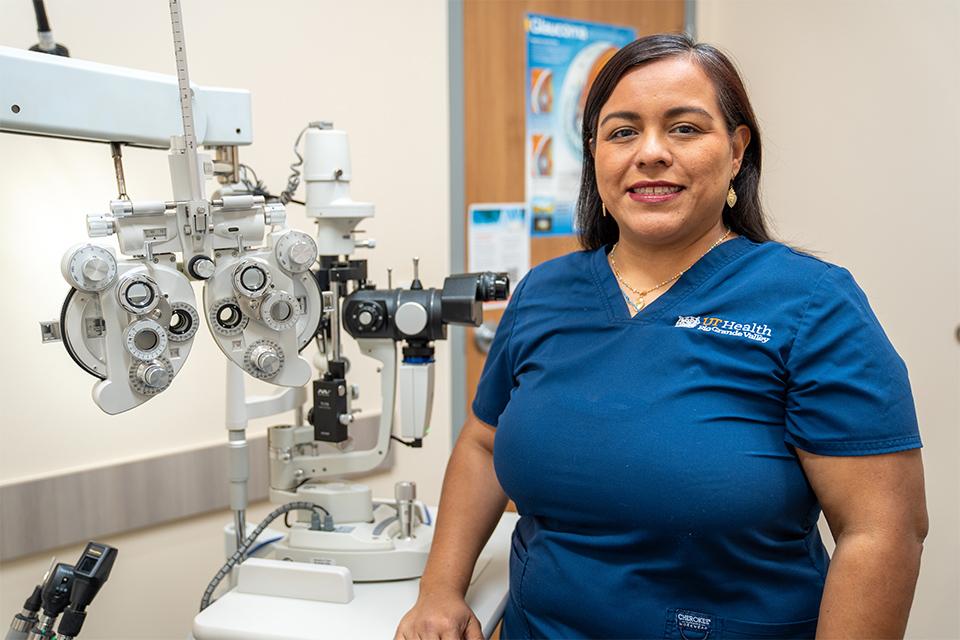“Cloudy vision doesn’t have to be part of getting older”

Photo above: Dr. Lorena Flores-Hernandez, optometrist and glaucoma specialist at UT Health RGV, encourages regular eye exams during Cataract Awareness Month to detect early signs of cataracts and other age-related vision issues. She said restoring clear vision can dramatically enhance independence, safety and overall quality of life. (UTRGV Photo by Heriberto Perez-Zuniga)
Annual eye exams could catch cataracts before they affect daily life
By Heriberto Perez-Zuniga, UTRGV Communications
EDINBURG, TEXAS – You’re driving down the road when headlights start to glare a little more than usual. Night driving feels tougher, and street signs appear less sharp. Things that once seemed bright now look dull or hazy.
If this sounds familiar, it may be more than just aging eyes; it could be a sign of cataracts.
June is Cataract Awareness Month, and Dr. Lorena Flores-Hernandez, an optometrist and glaucoma specialist at UT Health RGV, wants Rio Grande Valley communities to know that cloudy vision doesn’t have to be a part of aging.
“Cataracts tend to develop slowly and are most often age-related, but they can also be caused by diabetes, trauma, certain medications or even prolonged UV exposure,” Flores-Hernandez said. “They’re very common, especially after age 55, but they are also very treatable.”
RECOGNIZING THE SIGNS
A cataract is the clouding of the eye’s natural lens, gradually blurring vision. It can feel like looking through a foggy window: colors lose their brightness, glare intensifies and night vision may deteriorate.
In the early stages, cataracts may not cause noticeable symptoms. Over time, they can interfere with everyday activities like reading, driving or recognizing faces.
“Blurry vision, increased light sensitivity and frequent changes in your glasses prescription are all signs to watch for,” Flores-Hernandez said. “If you’re noticing any of those changes, it’s time to schedule an eye exam.”
According to the National Eye Institute, more than 24.4 million Americans aged 40 and older have cataracts, a number projected to rise to 50 million by 2050. People with diabetes are 2 to 5 times more likely to develop cataracts earlier and more rapidly than those without the condition.
That is particularly concerning for the Rio Grande Valley, where approximately 26.7% of adults have been diagnosed with diabetes – significantly higher than the national average of 14.7% according to the Centers for Disease Control and Prevention (CDC).
EARLY DETECTION
Flores-Hernandez emphasizes that Valley residents, especially older adults and individuals with diabetes, are at higher risk and should prioritize their eye health.
A comprehensive eye exam is the best way to detect cataracts early. These checkups assess visual acuity, eye pressure, retinal health and glare sensitivity.
“If cataracts are interfering with your daily life or affecting your eye health, we refer patients for surgery, which replaces the cloudy lens with an artificial one,” she said. “It’s a safe, common procedure that dramatically improves vision for most people.”
While cataracts aren’t always preventable, Flores-Hernandez suggests several ways to reduce risk and potentially slow their progression:
- Wear sunglasses to protect against UV rays.
- Maintain a healthy diet rich in fruits and vegetables.
- Quit smoking and limit alcohol consumption.
- Manage chronic conditions like diabetes.
- Get regular eye exams as recommended.
Flores-Hernandez encourages Valley residents to prioritize their eye health, not just for now, but for the future.
“Vision is one of our most precious senses,” she said. “Many people delay care because they think blurry vision is just a part of getting older, but it doesn’t have to be.”
Need an eye exam? Visit UTHealthRGV.org to schedule one today and learn more.

